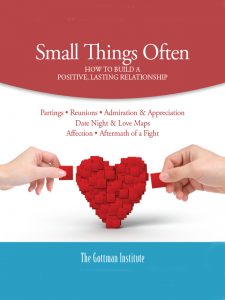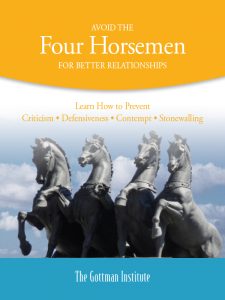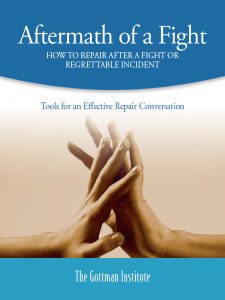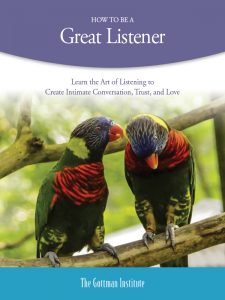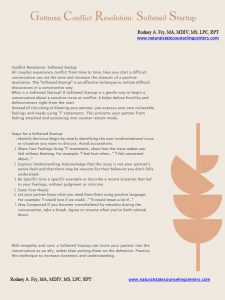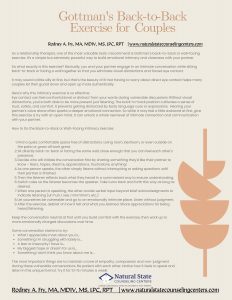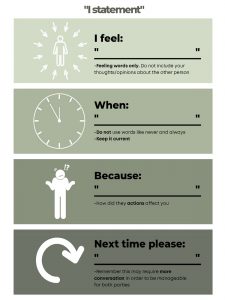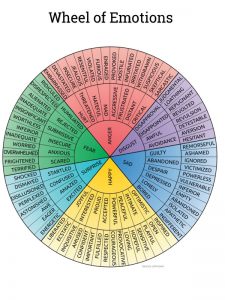-
Small Things Often
-
Avoid Four Horsemen
-
Aftermath of a Fight
-
Be a Great Listener
-
Fondness & Admiration
-
Relaxation
-
Conflict Resolution: Softened Startup
-
Back-to-Back Exercise for Couples
-
I statement handout Rodney Fry
-
Wheel of Emotions
Strengthening Your Relationship: Free Gottman Exercises for Couples
In the journey of love and partnership, nurturing a strong and lasting relationship requires effort, understanding, and effective communication. Drs. John and Julie Gottman, renowned psychologists and relationship experts, have developed a series of exercises designed to help couples deepen their connection, improve communication, and navigate conflicts with greater ease. These “Gottman exercises for couples” are valuable tools that can enhance intimacy and foster a deeper bond between partners.
If you’re seeking free Gottman exercises and activities to strengthen your bond, this comprehensive guide provides practical techniques inspired by the Gottman Method Couples Therapy. From Gottman couples exercises PDF guides to simple daily practices, you’ll find a wealth of research-backed exercises to reignite intimacy, whether you’re newlyweds establishing your foundation or a long-term couple aiming to rekindle the spark. The Gottman Method offers valuable exercises designed to foster deeper understanding, empathy, and connection between couples. These “gottman couples therapy exercises” help couples learn to communicate more effectively with “gottman therapy exercises for communication” and participate in free bonding activities. The Gottman approach provides a research-based framework for enriching your relationship, whether you’re looking for “free couples therapy” resources or want to find “gottman method couples counseling near me.” This introduction will guide you through powerful yet simple activities you can try at home.
By incorporating these exercises into your routine, you can breathe new life into your partnership and nurture the intimacy you both desire while exploring our free Gottman exercises for couples today to pave the way for a more fulfilling, harmonious relationship. Enjoy!
What is Gottman Method of Couples Therapy and How Does it Work?
Before delving into specific exercises, let’s understand the core principles of Gottman Couples Therapy. Based on decades of research, Drs. John and Julie Gottman identified three essential skills that are fundamental to fostering a healthy and thriving relationship:
- Enhancing Love Maps: Love Maps refer to the understanding of your partner’s inner world – their likes, dislikes, dreams, and fears. Couples who have strong Love Maps are more attuned to each other’s needs and emotions.
- Nurturing Fondness and Admiration: This skill involves recognizing and appreciating your partner’s positive qualities, even during challenging times. Couples who express fondness and admiration create a reservoir of goodwill that strengthens their bond.
- Turning Towards Each Other: Inevitably, conflicts arise in any relationship. The key is to turn towards each other, rather than away, during these moments. This skill emphasizes the importance of showing interest, affection, and support when your partner reaches out.
With these foundational skills in mind, let’s explore some free Gottman exercises for couples that can help you cultivate a deeper connection and navigate the highs and lows of your relationship.
Gottman Love Maps Exercise

A Gottman Love Map is a mental representation of your partner’s world. This exercise aims to deepen your understanding of each other’s innermost thoughts and feelings. Set aside time together to take the Love Maps Quiz. You can find a free version online or create your own questions. Some examples include:
- What are your partner’s top three fears?
- What is a childhood memory your partner often talks about?
- What is your partner’s favorite way to relax?
As you answer these questions, you’ll uncover new layers of understanding and strengthen your emotional connection.
Turning Towards Each Other: Daily Rituals of Connection
To practice turning towards each other, establish daily rituals of connection. These are small, intentional moments that allow you to show love and support. Examples include:
- Greeting Ritual: When you come home, take a moment to embrace and share a genuine hello.
- Appreciation Time: Before bed, share one thing you appreciate about your partner from that day.
- Technology-Free Time: Designate an hour each day to be technology-free, focusing solely on each other.
- 6 Second Kiss or Hug: Take the time to kiss or hug for 7 seconds, at the beginning of the day and/or night. Please remember to count!
By incorporating these rituals into your daily life, you prioritize your relationship and create opportunities for meaningful connection.
Relationship Guides by Gottman
Free Couples Therapy Activities
Small Things Often
Great Listener
4 Horsemen
Aftermath of a Fight
Fondness and Admiration
Relaxation
Incorporating these free Gottman exercises for couples into your relationship can yield profound results. Whether you’re aiming to deepen your emotional connection, improve communication, or navigate conflicts with grace, the principles of Gottman Couples Therapy provide a roadmap for success.
Remember, a strong and fulfilling relationship requires ongoing effort and dedication. By enhancing your Love Maps, nurturing fondness and admiration, and turning towards each other in times of need, you can create a resilient and loving partnership.
As you embark on this journey together, embrace these exercises as opportunities for growth and intimacy. By investing in your relationship today, you are laying the foundation for a lifetime of love and happiness.
Work with Gottman-trained therapists at Natural State Counseling Centers
Conflict Resolution: Softened Startup
Conflicts are inevitable in any relationship, but how you approach them makes a significant difference. Practice the “Softened Startup” technique when discussing challenging topics. This involves:
-
Gentle Start: Begin the conversation softly, without criticism or contempt. Use “I” statements to express your feelings.
-
Express Needs: Clearly state what you need or how you feel, focusing on the specific issue at hand.
-
Listen Actively: Practice active listening by paraphrasing what your partner says and showing empathy.
-
Take Breaks: If emotions escalate, agree to take a break and revisit the conversation when both are calmer.
By adopting a softened startup approach, you create a safe space for constructive dialogue and resolution.

As a relationship therapist, I recommend the Gottman Back-to-Back or Wall-Facing Exercise as one of the most valuable Gottman exercises for couples. It’s a simple but extremely powerful way to build emotional intimacy and closeness with your partner. This exercise is the perfect addition to any Gottman couples exercises PDF guide.
So what exactly is this Gottman exercise? Basically, you and your partner engage in an intimate conversation while sitting back-to-back or facing a wall together so that you eliminate visual distractions and forced eye contact.
It may sound a little silly at first, but that’s the beauty of it! Not having to worry about direct eye contact helps many couples let their guard down and open up more authentically.
I Statements – Stay away from You Statements
“You make me feel so mad”
“You’re always doing this”
“I feel like you never listen to me”
Perhaps you have heard or said something like this before? During an argument, or when you are feeling overwhelmed, you may scramble to find ways to express yourself and have others truly understand you. But the examples above are not good models to follow. Though these statements may encapsulate the frustration you may be feeling they are not entirely helpful or accurate.
An “I statement” is a specific way to express yourself while taking ownership for your feelings and identifying what behaviours that are upsetting you.
What’s important about an “I statement?”
“When you say, ‘you made me feel’, the other will likely respond with ‘no I didn’t’ but when you take ownership for your feelings, you are not opening it up for debate. ”
It’s important to recognize that you feel your own feelings. When you say, “You made me feel,” this does not properly reflect how humans work as emotional beings. Others are not capable of making us feel things, they are simply able to act in different ways that we may or may not respond to with a particular feeling. So, it should not be phrased “you made me feel” but instead “I feel… because…”. This will also lead to more productive conversations as it is less likely to trigger the other’s defensiveness. When you say, “You made me feel”, the other will likely respond with, “No, I didn’t,” but when you take ownership of your feelings, you are not opening it up for debate.
It is also important that you are careful not to confuse your thoughts, opinions, and judgments with your feelings. When one replaces their feelings with their thoughts, opinions and judgements it adds a bit of confusion to the conflict. For example, if you said, “I feel like you never listen to me,” you have replaced an emotional word with an opinion/judgment. That will then likely lead to the other denying it, which may cause you to feel like they are denying your feelings. When one can say how they are feeling without adding their thoughts, opinions and judgements about the other they can then begin the actual work of conflict resolution! This however does not mean that you cannot share what behaviours/actions upset you and why, but that comes second.
One should also be cautious when using “always,” and “never” when discussing someone’s behaviours. These descriptions stir up defensiveness and are rarely accurate.
An “I statement” looks like
“I feel emotion word, when identify the behaviours that upset you, because identify why it was upsetting. Next time please identify what you would like instead.”
Here are Some More Tips for Success:
Start with
- I feel…
- When…
- Because…
- Next time…
Follow that with
- Emotion words (sad, mad, hurt, embarrassed, alone, etc.)
- Identify the behaviors that upset you
- Identify why it was upsetting
- Identify what you would like instead
Tips
- Please don’t include your thoughts. Feelings only.
- Do not use words like never and always. Keep it current; do not bring up the past
- Explain how their actions affected you
- Remember this may require more conversations to be manageable for both parties.
Ready to give it a try yourself? Here are some printables to help you remember the steps and plan out how you can use “I Statements” more!

